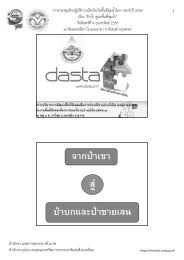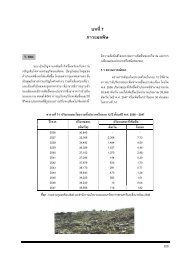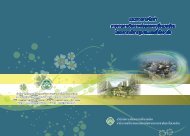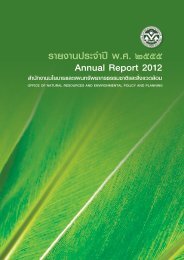ปีที่ 5 ฉบับที่ 3 กรกฎาคม-กันยายน 2552 - สำนักงานนโยบายและแผน ...
ปีที่ 5 ฉบับที่ 3 กรกฎาคม-กันยายน 2552 - สำนักงานนโยบายและแผน ...
ปีที่ 5 ฉบับที่ 3 กรกฎาคม-กันยายน 2552 - สำนักงานนโยบายและแผน ...
You also want an ePaper? Increase the reach of your titles
YUMPU automatically turns print PDFs into web optimized ePapers that Google loves.
ในปี พ.ศ. 2549 ข้าวสังข์หยดเมืองพัทลุงได้รับคําประกาศรับรอง<br />
ให้เป็นสินค้าสิ่งบ่งชี้ทางภูมิศาสตร์ Geographical Indication (GI)<br />
ตามพระราชบัญญัติคุ้มครองสิ่งบ่งชี้ทางภูมิศาสตร์ พ.ศ. 2546 โดย<br />
ใช้ชื่อว่า “ข้าวสังข์หยดเมืองพัทลุง (Sangyod Muang Phatthalung<br />
Rice)” (23 มิถุนายน 2549, ทะเบียนเลขที่ สช 49100011) นับเป็น<br />
ข้าวพันธุ์แรกในประเทศไทยที่ได้รับการคุ้มครองสิทธิประโยชน์แก่ชุมชน<br />
ผู้ผลิต<br />
สิ่งบ่งชี้ทางภูมิศาสตร์ คือ ทรัพย์สินทางปัญญาประเภทหนึ่งซึ่ง<br />
เป็นชื ่อของแหล่งภูมิศาสตร์ที ่ใช้กับสินค้าใดสินค้าหนึ ่งซึ ่งเชื ่อมโยงระหว่าง<br />
สินค้ากับแหล่งภูมิศาสตร์และระบบวัฒนธรรมหนึ่ง ทั้งในด้านปัจจัย<br />
ธรรมชาติ (ดิน-น้ํา-ลม-ไฟ) และปัจจัยอันเกิดจากมนุษย์ (ภูมิศาสตร์<br />
เฉพาะถิ่น ระบบวัฒนธรรม) ที่เกิดขึ้นมาช้านาน มีเอกลักษณ์เฉพาะพื้นที่<br />
ทั้งที่เกิดขึ้นในประเทศและต่างประเทศ<br />
ทั้งนี้ สิ่งบ่งชี้ทางภูมิศาสตร์มีลักษณะสําคัญ คือ 1. ถือเป็นทรัพย์สิน<br />
ทางปัญญาประเภทหนึ่ง 2. มีความเชื่อมโยงระหว่างธรรมชาติและมนุษย์<br />
3. เน้นผู้ผลิตกับพื้นที่ผลิต/ทรัพยากรในพื้นที่ 4. สินค้ามีเอกลักษณ์พิเศษ<br />
แตกต่างจากสินค้าชนิดเดียวกัน 5. ผู้บริโภคมั่นใจและพึงพอใจที่จะซื้อ<br />
สินค้าในราคาที่สูงกว่าสินค้าชนิดเดียวกันที่ผลิตจากที่อื่น<br />
Geographical indications are one way of identifying<br />
Intellectual Property. This can involve identifying geographical<br />
sites linked with production of certain items, especially<br />
when linked with culturally-specific production methods (e.g.<br />
the soil-water-air-fire cycle), as well as human factors (e.g.<br />
specific geography and cultural systems) that have been in<br />
existence for some time, with unique areas identified both<br />
domestically and overseas.<br />
GI can include such significant geographical features<br />
as the following: 1. Being a certain type of Intellectual<br />
Property; 2. Connecting people with nature; 3. Putting<br />
emphasis on the producers and production areas/area<br />
resources; 4. Having a unique identity distinct from other<br />
instances of the same type of product; 5. Giving consumers<br />
more confidence and satisfaction in buying products even if<br />
they have higher prices.<br />
GI categorization also provided five key benefits:<br />
1. Legal protection for the community to manufacture<br />
good quality products; 2. Adding value to merchandize as<br />
well as being a marketing tool to further develop trade;<br />
3. Motivating local producers to maintain product standards<br />
in order to maintain their own product images; 4. Promoting<br />
local industry to increase and distribute income locally;<br />
5. Building strong community and local pride in preserving<br />
indigenous wisdom as a part of tourism promotion.<br />
Mr. Samrueng also observed that rice is one of the<br />
world’s most important staple foods. Improving Sangyod rice<br />
to become a pure breed would lead to it becoming a<br />
stable and unique product both in height and length that<br />
could be grown and provide the same yield elsewhere, so<br />
long as the control gene was not altered.<br />
วารสารธรรมชาติและสิ่งแวดล้อมของประเทศไทย<br />
22

















